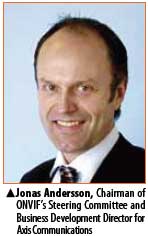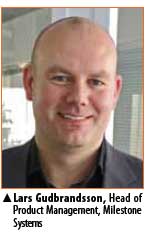Technology
Standards of Tomorrow
Access control is the next frontier for standards bodies. PSIA released its area control specifications in November 2011 for access control and intrusion, while ONVIF plans to introduce its access control specification in the first half of 2012. By the numbers, ONVIF is beating PSIA handily — more than 340 members and at least 1,300 conformant products — making it the organization to watch in 2012.
 ONVIF presently has multiple versions of its specification, which are not interoperable. The profile concept will be finalized in 2012, simplifying setup. “Users will no longer need to determine if specific devices introduced in ONVIF 2.0 are compatible with clients that conform to ONVIF 1.0 or with newer versions introduced in the future,” said Jonas Andersson, Chairman of ONVIF's Steering Committee and Business Development Director for Axis Communications. “Instead, users will be able to easily select the appropriate profile that offers interoperability at a specific functional level among units and software that fits their needs.”
ONVIF presently has multiple versions of its specification, which are not interoperable. The profile concept will be finalized in 2012, simplifying setup. “Users will no longer need to determine if specific devices introduced in ONVIF 2.0 are compatible with clients that conform to ONVIF 1.0 or with newer versions introduced in the future,” said Jonas Andersson, Chairman of ONVIF's Steering Committee and Business Development Director for Axis Communications. “Instead, users will be able to easily select the appropriate profile that offers interoperability at a specific functional level among units and software that fits their needs.”
Open standards are one of many factors, but not the panacea, to promote network video surveillance growth, cautioned Gary Wong, Senior Research Analyst for IMS Research. Two standards are better than none at all, as they provide a reference for buyers.
However, clear interoperability statements are missing from manufacturers, such as whether a network camera is compatible with a third-party VMS. “It looks to be a long way to go to achieve the goal,” said Carlos Eduardo Bonilha, President of Digifort. “It may be the idealist's dream.”
The IT world has flourished through standards, which is a long way off for security. “History gives us a clue what this industry will look like,” Shakespeare said. “It will go to a single standard.”
For enterprise customers, customized deep integration of systems serves specific needs. This is achieved through PSIM, which does not require systems to comply with PSIA or ONVIF standards. “These are not consumer-grade software applications,” Das of Verint said. While basic “plug-and-play” ONVIF products may be enough for small to midsize customers, large applications will demand more functionality. The future of standards may not be in the bodies, but in high-level PSIM deployments.
Other standards are mandated, such as RoHS certification. Grade 2 EN 50313 is required in Spain and in other European countries, said Noemi Ferrarons, Export Manager, JR Security Systems.
Regional VMS
The proliferation of network video has driven demand for VMS platforms. More vendors are emerging, which cater to specific regions. AxxonSoft dominates Russia, while SeeTec is strong in Western Europe. Digifort has a loyal following in Latin America, while China has homegrown offerings from NetPosa and Ragile. Genetec and Milestone Systems have global footprints, but face challenges in new markets from local contenders.
The more regional and productfocused VMS offerings become, the greater the risk of a split product market becomes. “With the security market being end user-driven and moving toward open systems, regional VMS will lead to VMS vendors having to settle with a reduced customer base,” said Balaji Srimoolanthan, Program Manager for Aerospace, Defense and Security at Frost & Sullivan.
However, country - specific offerings provide more support for products. “Deep integration has always been the aim of our policy, and the architecture of our products is optimized for it,” said Evgenia Ostrovskaya, Global Business Development Director, AxxonSoft. 
Others felt a global product strategy was more future-proof. “If country-specific standards emerge, VMS offerings may be too fragmented and therefore not scalable for global adoption, which will not benefit end users in the long run,” said Lars Gudbrandsson, Head of Product Management, Milestone Systems.
While a universal policy is ideal, it is not focused or customized enough to break into new markets. Scalability is also an issue, as increased camera counts will require server upgrades. New cameras and servers will need additional licenses, usually on a recurring annual basis, making the open path scalable but pricey.
To address specific market needs, add-on modules allow customers to do more than monitor cameras, Bonilha said. Wong added, “There has been an ongoing trend among the VMS companies to begin to focus on the integration of equipment beyond just video surveillance equipment, such as life safety sensors.”
A global policy cannot overlook localc omplexities .Genetec encourages engineers to see how solutions are used in the real world and partners with local hardware manufacturers. “In video, data just keeps coming, so there is no second chance; you must get it right the first time,” said Charles Cousins, MD of APAC, Genetec.